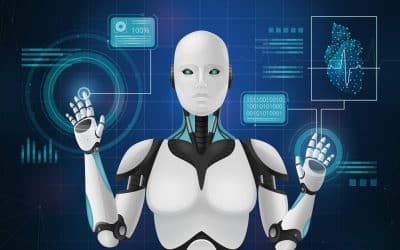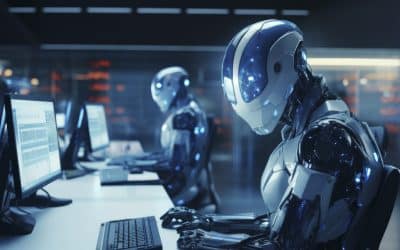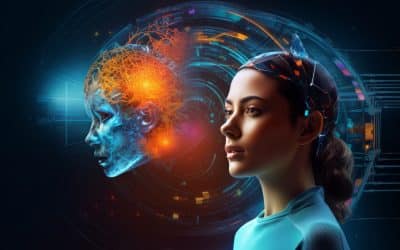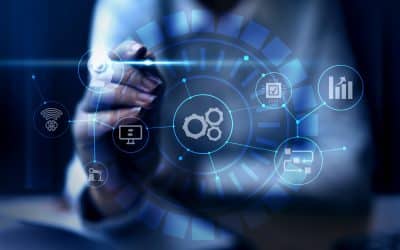Machine learning (ML) has grown into an integral technology element across a broad range of uses. It includes natural language processing, computer vision for fraud prevention, demand forecasting suggestions, preventive maintenance, and document processing. Maximizing the advantages of machine learning on a larger scale requires standardizing an advanced ML development procedure throughout your company. Modernizing your Machine Learning Development Services procedure can speed up the pace of your innovation by creating scalable infrastructures that are integrated with tools and safe ways to use ML. Also, a variety of tools are available for data scientists, developers, and programmers across any ML skills, as well as efficient resource management that keeps costs down.
Modernizing the development of your machine learning process will speed up your growth rate by offering a scalable platform, integrated tools, and healthy methods for the safe use of ML. The choice of available tools for developers with all scientific levels and efficient management of resources to keep costs to a minimum.
This article offers a guide to modernizing your ML development processes in 2024.
What Exactly Is Machine Learning?
Machine learning (ML) is a broad phrase describing any computer science technology that employs algorithms that mimic how humans’ brains learn information. It is a subset of AI where computers are programmed to acquire knowledge from data replicating human cognitive processes. For business, that means harnessing vast volumes of information to gain valuable insights, efficiency in operations, and improved customer service. This distinction between general AI is essential for executives to understand, which will ensure an effective and focused adoption.
What is ML Modernization?
ML Modernization updates and optimizes existing machine learning models and technologies using newer versions. This will aid in improving their performance, efficiency, and adaptability and ensure their good condition. This allows organizations to remain competitive by increasing the precision and efficiency of their machine-learning models and machines. ML modernization is a constant process that demands companies to be up-to-date with modern algorithms, technologies, and best practices to ensure their ML system is efficient and valuable.
The Necessity Of ML Modernization
ML modernization ensures businesses stay ahead and benefit from this fast-growing technology. It is essential to stay ahead of technological advancements and changing business demands. This allows organizations to harness the capabilities of Model Validation Techniques to streamline processes and increase their effectiveness. Through modernizing ML, companies can increase the accuracy of their predictions, automate complicated data-driven processes, and gain insight from their data much faster. Furthermore, ML modernization makes adopting advanced technologies and creating better models much more accessible. A few of the main reasons it is now a crucial requirement are as follows:
Adapting To The Constantly Growing And Ever-Changing Nature Of Information
Models for ML are powered by information. The success of implementing AI or ML strategies could be based on the ability of your company to collect massive amounts of data from an extensive and varied set of sources, i.e., the customers you serve. However, the true challenge is ensuring that your data represents your customers. When you first started building the ML models, your data had to have risen dramatically, and how data was gathered had also altered drastically. Furthermore, caution must be maintained to ensure no biases from human sources leaking into the information. The criteria for selecting data is crucial to choosing the proper criteria for the input to ML models.
Integration And Advancement With The Latest Technologies
To increase the effectiveness of ML models, one needs to incorporate them into the most recent technologies in the field. Such as advanced computing techniques, edge computing, cloud computing, live streaming of data methods, IoT, and so on. This will allow them to work in a distributed setting and collect data from more recent sources.
Cost Optimization
Modernization could reduce costs by reducing computational requirements, enhancing energy efficiency, and improving model architectures. By optimizing the ML system, firms can obtain more efficient results using fewer resources, which results in reductions.
Conformity To The Requirements Of Regulatory Compliance
Data protection laws like regulations for data protection, such as the General Data Protection Regulation (GDPR), are made more manageable once technology for ML is upgraded. Implementing privacy-enhancing methods, encryption methods, or safe methods of handling data ensures that you comply with ethical and legal standards.
Advantages Of ML Modernization
We’ll take an overview of the advantages of ML modernization.
Accelerate ML Innovating
By modernizing the ML process, companies can reduce the time required to develop ML models from months to weeks. This enables organizations to ship their products faster and gain a competitive advantage.
Improved Accuracy
Modernized ML models will enhance the precision and accuracy of predictions, resulting in better results and understanding.
Real-Time Processing
Modernizing ML models allows organizations to process data in real-time, enabling them to make strategic business decisions quickly.
Enhanced Security
Modernizing ML will increase businesses’ security capabilities by employing advanced algorithms to identify and stop cyber-attacks, fraudulent activities, and other malicious acts.
Cost Reduction
Modernizing ML companies can reap benefits by reducing costs through automation of processes and by reducing manual needs.
Enhanced Productivity
Allow teams to collaborate for the same purpose for a better service to your clients.
Best-Practice Approach To Machine Learning Model Development
We’ll now overview the most effective method for the ML model creation process in 2024.
Business Objective
Determining the business goals for the machine-learning (ML) project might appear to be a straightforward starting point. Still, you’d be amazed at how many initiatives begin with a vague objective of “finding insights” into data that has been gathered for years. Machine learning models operate on an excellent level. Unclear objectives, like “reduce manufacturing costs,” are not sufficiently specific. These objectives must be reorganized into “reduce equipment failures” or “improve operator productivity.” It’s essential to measure the improvements you’d like to see and then translate the goal into actual return on investment to make informed choices regarding priority and the allocation of resources. Solution Design
ML models are typically considered isolated laboratory studies, leaving out the crucial process of creating a comprehensive, interoperable business system interface. Data scientists make an intuitive user interface that allows users to play independently using various scenarios and settings. Clients can seek advice from anyone directly affected by a business decision without time limitations or the requirement for manual modification of the model, which would require an on-site presence by the model designer. It is possible to use the model continuously to keep track of progress and observe any changes. The results from using the model’s suggestions could feed into the model to improve the model’s output and be used in future expansion initiatives.
The complete solution to machine learning will include a method for incorporating the model into the existing business processes. The model should consider the end-user needs for interfaces, training, and requirements regarding its quality, periodic updates, and an overview of its release procedure.
Model Creation
The creation of models is usually one of the most significant stages in the creation process. Its goal is to attain a high quality of the model’s accuracy, at least as close to 100 percent as feasible. Three main components affect the accuracy of machine-learning models: the suitability of the algorithm, the quality of the features, and the quality of the data used for training. The modeling process constantly improves these three aspects until the desired accuracy has been achieved or progress is stalled.
The initial step in modeling is choosing the most suitable algorithm. This process is used on the initial training information to construct or refine the model. There are hundreds of machine learning techniques accessible to data scientists, and more are being developed every single day. A suitable method for solving a machine learning issue is the first step to creating an efficient Machine Learning Model Validation that will be used as an enterprise tool.
The other component essential to model accuracy is the quality of the feature set. Features are the attributes of the parameters within the data that influence the model. The method of determining characteristics is known as feature engineering. The features set informs the model, “These are the things that make the most difference for this problem.” It is the algorithm’s job during learning to determine what features to look for within the data used to train it for a more precise or “correct” result.
The precision of the initial model created using the selected algorithm is reported as the base accuracy. For the traditional ML model, and even if the algorithm is chosen correctly, the accuracy of baseline models is often low, around 70. Many algorithms come with modifications or adjustments, referred to as hyper-parameters. Occasionally, accuracy improvements can be achieved just by manipulating these settings. As models develop, the optimal parameters for the hyper-parameters may change, so it’s important to revisit them regularly as part of the modeling process. The amount of time needed for these tests is short.
Making the features set may take a while. A model, for instance, for predicting home prices, could utilize features such as area, location, and market inventory to arrive at an estimate with around 70 percent precision. Some additional factors are apparent and tangible, like the amount of bedrooms, amount of bathrooms, and the presence of garages. Let’s assume that each of the three elements adds 5 percent accuracy, which results in a model having an accuracy of 85. The model will need to go further to achieve higher accuracy. An attractive view, as well as the longevity of the structure, can improve accuracy by 2% per feature, which is a total of 89 percent.
The data used in training is a third factor in the model’s accuracy. The chart below illustrates the typical relationship between the accuracy of the model and the quantity of data used in training. There’s a time when the accuracy is at the maximum level and then falls off. The key is to gather enough examples of training to bring it at or close to the maximum level of accuracy. It’s typical for data used in training to be in short supply, especially if algorithms require labels, which many have. A sufficient amount of training data is costly and challenging to acquire; however, many traditional algorithms require minimal to moderate amounts of data to attain the necessary levels of precision.
Model Evaluation
Once all the previously discussed designing and planning phases have been completed, the model evaluation process is a point of reference. In the course of weeks or even months during the testing phase of design and development, the group must refocus on the business elements of the plan to remain focused on the end goal of the business.
At this point, the team is tasked with examining the model results to assess the effects of any modifications or changes, reviewing risks, and taking a call on deployment. If there is a delay in achieving the required precision, it is time to determine the issue and decide whether to rethink the model’s concept, change a part of the model, or even rethink the business’s initial goal.
Solution Deployment
Depending on the software, it is possible to deploy models in various ways; however, the model deployment process follows the procedures outlined in the deployment plan. Be aware that even the most powerful machine learning systems won’t yield the expected outcome for your business without a change in culture and behavior. A successful implementation of Enterprise AI is equal parts technology and people.
Continuous Improvement
The most important task of a machine learning program is the ongoing improvement phase, which is often straightforward. This includes tracking and reporting the progress made against targets. Learn from the experience and gain insights. Improve and revise goals, solutions, or models. However, these issues need to be more complex. Because the potential benefits and spinoffs aren’t entirely understood upfront, continual enhancement is the procedure’s most thrilling and enthralling aspect. ML model creation is never “done.” By definition, models “learn” and get more exact with time. Some models even grow far beyond the scope of their initial development. The models can be analyzed to uncover insights that can lead to concepts for related enhancements to business processes or even drive improvement to the ML solution in itself. One sure indicator of a health ML project is if it is growing when groups are identified or separated. Each group has a unique model to optimize it for specific characteristics of each group.
For many executives, one of the biggest challenges regarding the shift towards Enterprise AI is the uncertainty and confusion surrounding initial ML modeling. It’s essential to stay focused on the beginning of projects, provide the constant commitment and tenacity necessary for this transformational leap, and be confident that the investment will ultimately be worthwhile.
Use Cases Of ML Model Modernization
Let’s take a look at the use cases for ML modernization.
Accurately Analyze Images
Design computer vision models that can be used for various applications, including object detection, medical diagnosis, and autonomous driving. Examine images with precision.
Automated Text Processing
Create ML models to sort, analyze, and interpret data in handwritten or electronic documents. This allows you to analyze documents more quickly, efficiently, and cheaply. Automate the process of feature engineering to accelerate the development of the model.
Self-Operating Model Retraining
The self-operating method of constantly retraining machines ensures they are up to date with evolving circumstances in business, data sets such as business and economic conditions, etc.
Detect Anomalies Quickly
The presence of anomalies can be identified within data to aid in the prevention of deceit as well as preventive maintenance.
Give Personalized Suggestions
ML modernization is a great way to significantly improve customer satisfaction and grow businesses fast by offering customized digital experiences.
Final Thoughts
Machine learning (ML) is now an essential technology component for companies to enable real-world innovation. Utilizing the power of machine learning in a wide-scale manner is standardizing a contemporary ML process throughout the business. Modernizing your ML development processes can speed up the pace of your innovation with a scalable and flexible infrastructure. This infrastructure can include an integrated tooling system, healthy methods that allow the responsible use of ML, and a range of tools available to data scientists and Machine Learning Development Company across any ML level. Also, efficient resource management is needed to keep costs down.
Modernizing your machine learning procedures can help companies like yours achieve their business goals and boost the pace of innovation. It can help overcome the difficulties of complex, time-consuming, and expensive self-managed machine intelligence platforms.











